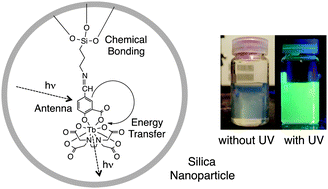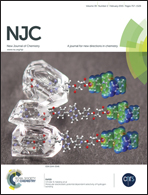Fluorescent silica nanoparticles modified chemically with terbium complexes as potential bioimaging probes: their fluorescence and colloidal properties in water†
Abstract
It generally requires a complicated reaction protocol for the synthesis of silylated fluorescent lanthanide complexes. In this study, a silylated terbium complex was prepared by a very simple procedure through formation of a Schiff base between a terbium complex bearing a formyl group and 3-aminopropyltriethoxysilane. Using the silylated terbium complex, highly fluorescent silica nanoparticles modified chemically with terbium complexes (Tb-SNPs) were efficiently synthesized by a reverse micelle method with Triton X-100 as a surfactant in cyclohexane. The fluorescence properties of Tb-SNPs were remarkably improved by photostability, pH dependence and fluorescence lifetime, compared to free terbium complexes. Also, Tb-SNPs hardly aggregated under aqueous conditions with different salt concentrations and pHs. From these results, it was found that Tb-SNPs are applicable under physiological aqueous conditions. Furthermore, as an application model, Tb-SNPs were used as the fluorescent label for the imaging of African green monkey kidney cells.


 Please wait while we load your content...
Please wait while we load your content...